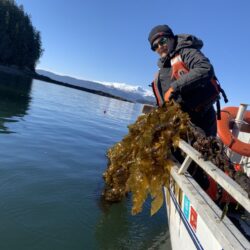Schery Umanzor
A Dive Into the Surprising Reproductive Life of Seaweed
About the Speaker
Dr. Schery Umanzor completed her doctorate in marine ecology at CICESE, Baja California, in 2017. Shortly after, she joined the Seaweed Biotechnology Lab, where she focused on selective breeding sugar kelp. In 2020, she was recruited as a Mariculture faculty at the University of Alaska Fairbanks. Her expertise includes macroalgal ecology, ecophysiology, and cultivation. Her current projects include the development of low-cost tools and methods for the adequate selection of farm sites, cultivation protocols for red seaweeds, measuring the magnitude of ecosystem services by kelp farms, and assessing potential benefits of co-producing oysters and kelp.
A Dive Into the Surprising Reproductive Life of Seaweed
Seaweeds may look like plants but do not reproduce like most plants, with flowers and pollen. The life history of seaweeds is complicated and fascinating, and this is what really differentiates them from plants. Seaweeds can go through life stages so different that, in the past, they have been mistaken for separate species. Seaweeds can reproduce using different strategies. Reproduction in some seaweeds can involve either exclusively sexual or asexual phases, while other species display an alternation of generations that involves both phases in succession. As with all in life, seaweed reproduction strategies have tradeoffs. Asexual reproduction allows for fast propagation but carries an inherent danger of limited genetic variation. Sexual reproduction ensures better genetic variation but carries a huge match-making problem. In this talk, we will overview seaweeds in general and then dive into the intricacies of seaweed reproductive life.
